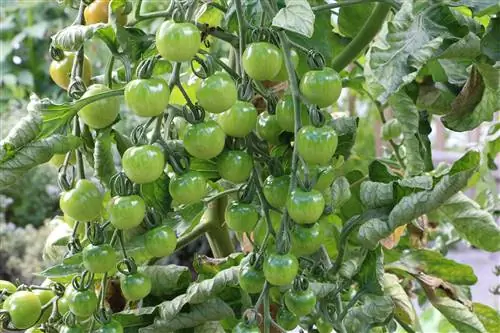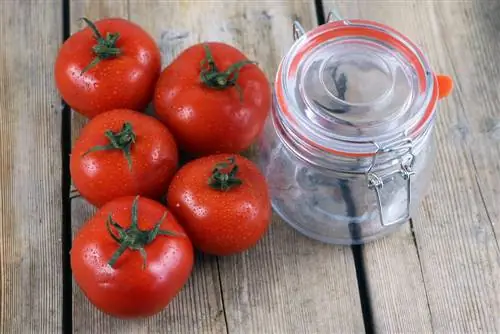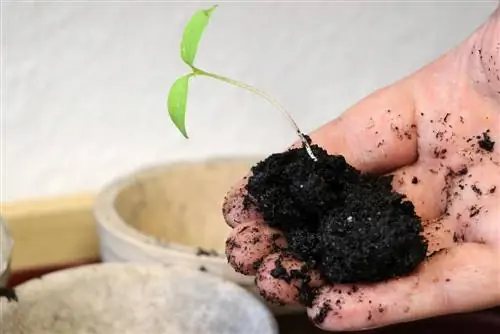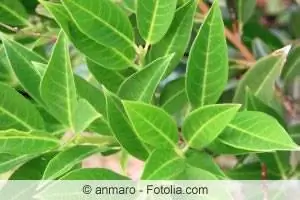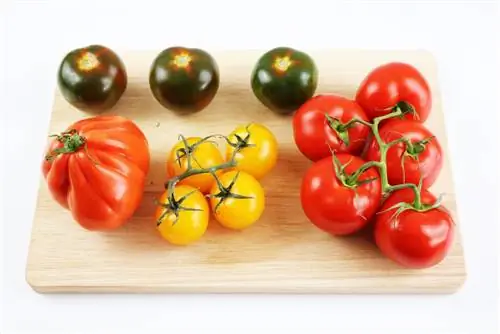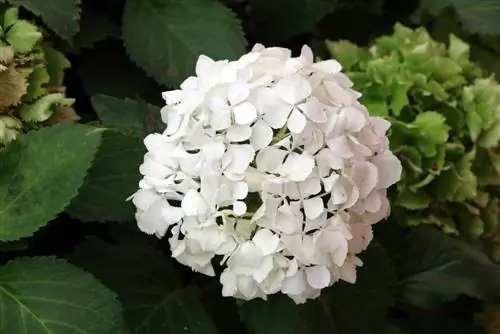- Author admin [email protected].
- Public 2023-12-17 03:39.
- Last modified 2025-01-24 12:45.
Tomatoes require a consistently high amount of nutrients to develop flowers and fruits. In addition to choosing the right fertilizer, the amount and frequency also play an important role. You can find all the essential information for optimal dosage here.
A full nutrient supply is essential for heavy eaters. Tomatoes therefore need fertilizer at regular intervals. This guarantees lush flowering and thus fruit development. It is also an important basis for a he althy immune system.
Essential minerals
A full mineral supply is essential for many reasons. Among other things, it is necessary for a good immune system. It is also essential for lush fruit development. The following nutrients are required throughout the entire life cycle:
- Calcium: 2.3 grams, essential for deacidification, excess leads to stunting, deficiency leads to alkalinity
- Potassium: 3.8 grams: essential for photosynthesis and fruit development, excess is harmless, deficiency results in curled leaves and tasteless fruits
- Magnesium: 4 grams: essential for water balance, excess is harmless, deficiency leads to yellowing of the leaves
- Phosphate: 0.5 grams: essential for all metabolic processes, excess is harmless, deficiency leads to yellow-brown leaves
- Sulfur: 0.7 grams: essential for the formation of enzymes and amino acids, excess leads to acidification, deficiency leads to yellowing of the leaves
- Nitrogen: 3 grams: essential for the formation of chlorophyll and growth, excess leads to height, deficiency leads to stunting
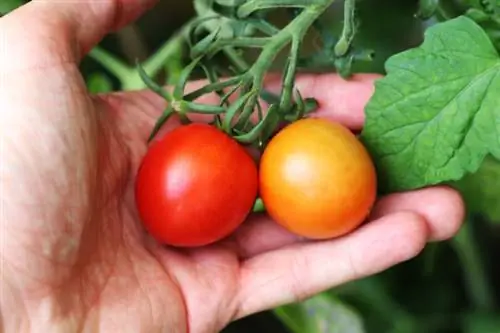
The requirements of the individual varieties may differ slightly from the above information. Please find out about the exact conditions in advance.
Fertilize tomatoes in the development stages
The life cycle of the tomato plant includes three stages of development. Nutrient requirements vary depending on the phase. It increases steadily with age.
- Seedlings: no fertilization necessary
- Young plants up to two months old: low nutrient requirement of one tenth of the listed values per individual fertilizer application
- adult plants: consistently high nutrient requirements of four tenths of the listed values per individual fertilizer application
Frequency of fertilization
How often the tomato plants need to be fertilized depends on the stage of their development and on the variety. As already mentioned before, no additional minerals should be added to seedlings. Young plants should be slowly introduced to regular fertilizer every three weeks. Adult tomato plants require a new supply of nutrients approximately every two weeks.
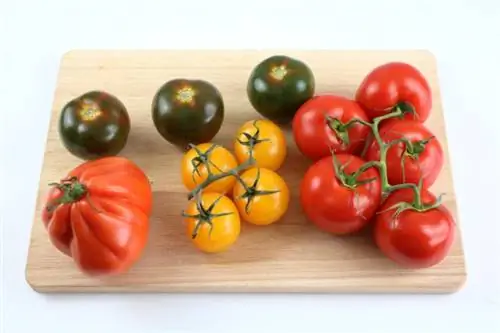
There may be slight differences in frequency depending on the individual variety. Particularly high-yielding varieties generally require more minerals. These species include Celsior, Siberian pear, black cherry and sugar grape, among others. In contrast, genera that descend from wild tomatoes are rather frugal.
Fertilizer selection
In order to fertilize as naturally as possible, we recommend using an organic fertilizer. Alternatively, the use of a mineral fertilizer is also conceivable. However, this can lead to over-fertilization. Particular attention should therefore be paid to the nutrient composition of the individual product. But under-fertilization can also lead to serious impairments.
Consequences of over- and under-fertilization
Growth disorders (height or stunted growth)
Growth disorders are among the most common consequences of inadequate fertilization. The nutrient nitrogen is the main driver of incorrect development. A proportion that is too high will result in uncontrolled height growth. In contrast, inadequate nutrition leads to stunting. Regular external inspection of the plants is therefore essential. As soon as signs of unusual growth are noticed, the first measures should be taken. Water the plant generously to flush out the excess nutrients.
Discolored and deformed leaves
The discoloration of the leaves usually only occurs when there is inadequate supply. In addition to a lack of magnesium, phosphate and sulfur can also be the cause. Deformities are commonly due to a potassium deficiency. An exact anamnesis is often not possible if there is any damage. Therefore, give the tomato a complete fertilizer that contains all minerals.
Burned roots or leaf edges
The burnt roots and leaf edges are an equally common result of over-fertilization. However, sunlight does not play a role here. Due to a permanently increased nutrient concentration, the plant continually loses fluid. This lack of water is reflected in burns on the roots and leaves. In this case too, increased water supply is essential. However, plant parts that have already been burned can no longer be restored.
Organic fertilizers for fertilizing tomatoes
Stinging nettle manure
The manure from nettles has been used as a natural tonic for many decades. Making the brew is extremely simple and can be done in just a few steps.

- Crush 1 kilogram of fresh or 200 grams of dried nettles
- Pour 10 liters of water into the nettles and stir vigorously
- optional: Addition of rock dust to eliminate odor
- Seal the container airtight
- stir daily for at least 10 to 14 days until no more bubbles appear
- Separate liquid from plant residue using a sieve
Before using the manure, it must be diluted in a ratio of 1:10. The resulting mixture can then be generously distributed around the tomatoes every four weeks.
Note:
Stinging nettle broth is also suitable as a natural plant protection product against aphids, spider mites and whiteflies.
Compost
Compost is also an extremely natural fertilizer.
In addition to grass and shoot cuttings, withered plants and plant residues can also be piled up in the compost. Over time, the decomposition processes create a nutrient-rich humus soil.
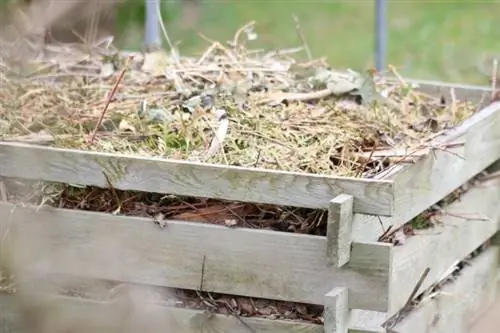
In order to get the greatest possible effect from the humus, large-scale fertilization in autumn is recommended. To do this, the compost is distributed evenly throughout the bed. It is then incorporated into the existing soil. The microorganisms and nutrients contained can therefore spread thoroughly until planting next year. Optionally, additional compost can be added in the spring.
Tip:
All animal remains such as bones and meat are not suitable for compost. In addition, all types of processed substances are not suitable for humus.
worm tea
Worm tea, also known as compost tea, is a waste product of making compost with worms. However, its use is nowhere near as widespread as that of humus. This is essentially due to the significantly more difficult extraction. When the compost is stored in a commercial composting site, the liquid continually seeps into the ground. A special worm composter is required to collect them. The materials to be composted are filled into these. The resulting liquid is then collected in the lower area of the container. It can be easily tapped for use using a tap.
Due to the high nutrient density, it is also recommended to fertilize the worm tea every four weeks. Diluting the tea with additional water can stretch the liquid. In this condition, fertilization is also possible every two weeks.
Note:
Alternatively, worm tea can be made from water, worm humus and molasses. The relevant materials can be purchased from specialist retailers.
Organic (liquid) fertilizer
Organic fertilizers can also be purchased ready-made in stores. The nutrients are presented either in powder form, granulated or liquid. However, the compositions usually only differ slightly from one another.
While solid variations have to be worked into the soil, adding liquid fertilizers to the irrigation water is sufficient. In terms of manageability, liquid fertilizers in particular are extremely popular. Exact dosage information is noted on the packaging. Due to the short effective periods, regular fertilization every one to two weeks is generally recommended.
Supplementary fertilizer from home remedies
Basically, the aforementioned complete fertilizers provide the tomato plants with all the important nutrients. However, an increased mineral requirement can arise for various reasons. Examples include unfavorable location conditions or illness.

In these cases, individual substances can be supplied inexpensively using home remedies. However, it is important to note that the following home remedies are only suitable as a supplement. Fertilization alone is strongly discouraged.
- Eggshell: contains calcium and magnesium
- Coffee grounds: contains potassium and phosphorus
- Milk: contains calcium and phosphorus
- Natron: contains sodium

